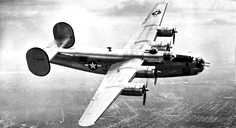Company Milestones
Company MilestonesWe Played a Major Role in the "Arsenal of Democracy" During World War II
From 1942 to 1945, Ford Motor Company completely shut down civilian vehicle production to dedicate all its resources to the Allied war efforts as a leader in the "arsenal of democracy."

The U.S. Air Force invested $2 million in facilities and equipment in return for the company’s promise to build the Consolidated B-24 Liberator bomber. By the war's end, Ford Motor Company had built more than 8,600 B-24s.
B-24s Built at Willow Run
B-24s were built near Ypsilanti, Michigan, at a large tract of land called Willow Run. Henry Ford owned the land and ordered the construction of a mile-long, L-shaped plant to produce the B-24 Liberator bombers for the military. Henry's son, Edsel Ford, and Charles Sorensen, head of production for Ford Motor Company, headed the project. At its peak, the Willow Run facility was staffed by nearly 50,000 workers.
By 1944, the company was making 48.5 percent of all B-24s produced. In 1945, the figure had increased to 80 percent. Mass production on this scale—assembly of more than a million plane parts held together by hundreds of thousands of rivets done at stations extending 3,000 feet—had never been attempted. By the end of the war, the plant was turning out 540 of the four-engine planes a month, meaning that a plane was assembled every 59.34 minutes.
Wartime Focus from Ford Workers Around the World
In addition to manufacturing B-24 bombers, at plants around the world, Ford autoworkers devoted their skills to building aircraft engines, jeeps, M-4 tanks, parts, engines and more.
In England, the Dagenham plant produced Ford military trucks and Bren-gun carriers for shipment to the Allied effort in North Africa. British Ford workers built more than 30,000 super-charged V-12 engines for Mosquito and Lancaster bombers, helping England's Royal Air Force defend British skies against air attacks.
Historic Sites

The Rouge
Ford's Rouge Complex is known as an industrial trend-setter in both the 20th and 21st centuries.
Inn on the Tarmac
More than 90 years, the Dearborn Inn was one of the first airport hotels.
Fair Lane: Where The Fords Called "Home"
Henry and Clara Ford's final home, Fair Lane, included a hydroelectric powerhouse and nature areas and is still a landmark today.








